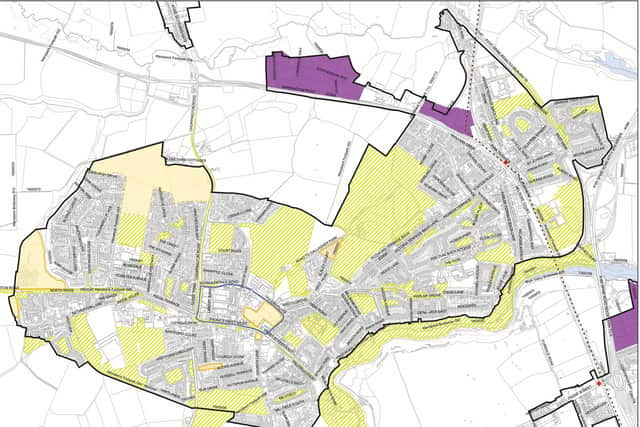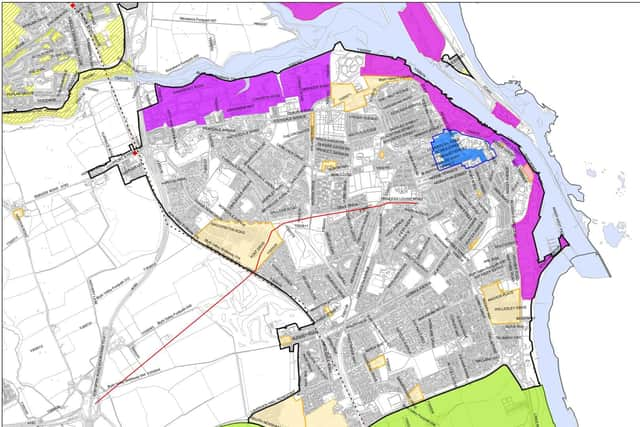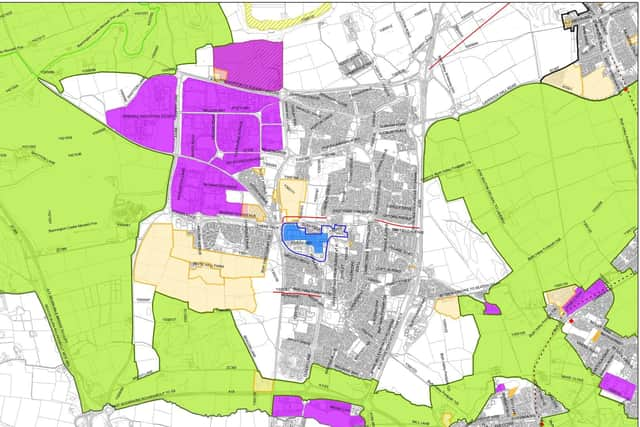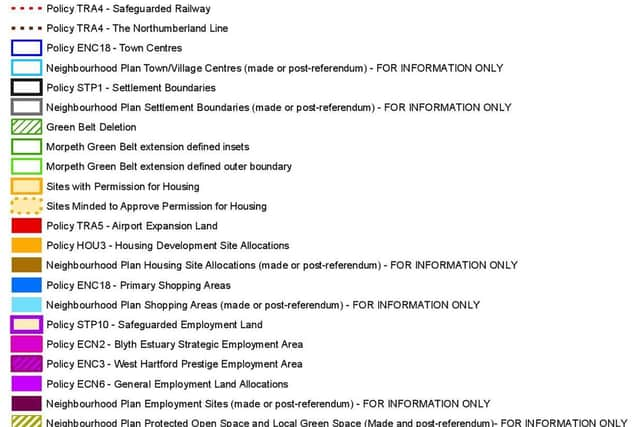Local Plan proposals for main towns: South-east Northumberland


Residents, businesses, community and voluntary groups, town and parish councils, and anyone with an interest in the future of the county are invited to have their say on the framework that will guide development up to 2036.
The public consultation closes at 5pm on Wednesday, August 15, and the plan and details on how to respond are at www.northumberland.gov.uk/localplan


Advertisement
Hide AdAdvertisement
Hide AdThere are 12 main towns designated in the document and here are the details for the four in south-east Northumberland – Ashington, Bedlington, Blyth and Cramlington.
ASHINGTON
Ashington will continue to act as a key hub for housing, employment, education, healthcare, retail, transport and tourism.
It will be a main focus for development to underpin its social, economic, environmental and cultural regeneration.


The Local Plan defines a settlement limit for the town to cover the plan period, with a view to containing the spread of development and maintaining the town as a sustainable settlement.
Advertisement
Hide AdAdvertisement
Hide AdThe proposed requirement for additional dwellings between April 2016 and March 2036 is around 1,600 over the plan period (80 per year).
This level of housing development will be required to support the existing housing market by helping to extend choice to achieve a balanced housing market.
The plan does not propose new allocations as this requirement can be meet through completions and commitments on sites with permission or minded to approve applications.


The town has a good supply of already serviced employment land, which includes the strategically important Ashwood Business Park, (which forms part of an Enterprise Zone that has added incentives for employers to locate there).
Advertisement
Hide AdAdvertisement
Hide AdOne additional employment land allocation is proposed in the north of the town, to supplement available land in that area.
Ashington’s centre falls into the top level of the hierarchy of town centres, being a ‘main town – larger centre’ with a good level of retail provision along with wide ranging town centre community facilities.
It is reasonably well provided for in terms of accessibility by public transport and has a good level of off-street car parking.


It acts as a community hub for a large population covering the town and its hinterland. This role along with its vitality and viability as a centre will be protected through policy.
Advertisement
Hide AdAdvertisement
Hide AdThe town lies beyond the green belt, which surrounds Morpeth and the outer boundary of which lies to the west of Ashington.
The town has seen important investment, such as the recent establishment of a high-tech paint manufacturing plant.
There are key opportunities to improve the town’s connectivity as an employment hub and residential area through the proposed Northumberland Line, which will reintroduce passenger rail services to the existing mineral line.
The town includes key services. The new leisure and sports centre and library facility are now open, but the centre offers scope for further regeneration.
Advertisement
Hide AdAdvertisement
Hide AdAshington is close to the coast and key visitor attractions, notably the Woodhorn Museum.
BEDLINGTON
Bedlington will continue to act as a key hub for housing, employment, education, healthcare, retail, transport and tourism.
It will be a main focus for development to underpin its social, economic, environmental and cultural regeneration.
The Local Plan defines a settlement limit for the town to cover the plan period, with a view to containing the spread of development and maintaining the town as a sustainable settlement.
Advertisement
Hide AdAdvertisement
Hide AdThe proposed requirement for additional dwellings in Bedlington between April 2016 and March 2036 is around 840 over the plan period (42 per year).
The plan does not propose new allocations as this requirement can be meet through completions and commitments on sites with permission or minded to approve applications.
No significant additional employment land allocations are proposed over and above existing available land.
Bedlington continues to have a strong relationship with adjacent main towns for employment and the nearby Blyth Estuary north area provides major energy and marine-related employment opportunities.
Advertisement
Hide AdAdvertisement
Hide AdBedlington falls into the second level of the hierarchy of town centres, being a ‘main town – smaller centre’ with good local retail provision along with a reasonable range of town-centre community facilities, serving the town itself and with a modest hinterland.
This role along with its vitality and viability as a centre will be protected through policy and there are proposals to create new retail and service development using vacant and backland areas in the heart of the defined centre.
The town lies beyond the green belt, the outer boundary of which lies to the west of Bedlington.
The town’s proximity to larger service centres may mean that it is less successful in attracting a full range of services that these towns offer.
Advertisement
Hide AdAdvertisement
Hide AdHowever, the strategy allows the scope for initiatives to be taken to bring services to Bedlington.
This issue may be partly addressed if the town’s connectivity can be improved through the proposed Northumberland Line, which will reintroduce passenger rail services to the existing mineral line.
This line and its associated branch lines (including the branch line from Bedlington to Morpeth via Choppington) and supporting infrastructure will be protected.
BLYTH
There is significant economic growth potential around the Blyth Estuary, which includes sites with Enterprise Zone status.
Advertisement
Hide AdAdvertisement
Hide AdOpportunities exist that build on existing assets including the National Renewable Energy Centre (NaREC) and the Port of Blyth which is a sizeable commercial port with deep-water harbour and large-scale warehousing facilities.
Specific sectors being targeted include offshore oil and gas, renewables and advanced manufacturing.
Blyth will continue to act as a key hub for housing, employment, education, healthcare, retail, transport and tourism.
It will be a main focus for development to underpin its social, economic, environmental and cultural regeneration.
Advertisement
Hide AdAdvertisement
Hide AdThe Local Plan defines a settlement limit for the town to cover the plan period, with a view to containing the spread of development and maintaining the town as a sustainable settlement.
The Blyth and its estuary areas provide the county’s main single opportunity for economic growth through the port and Energy Central functions referred to above.
The proposed requirement for additional dwellings between April 2016 and March 2036 is around 1,800 over the plan period (90 per year).
The plan does not propose new allocations as this requirement can be meet through completions and commitments on sites with permission or minded to approve applications.
Advertisement
Hide AdAdvertisement
Hide AdThe Blyth Estuary Strategic Employment Area offers upwards of 200 hectares of interconnected sites for anticipated growth in strategically important sectors – specialised uses relating to energy, the port, marine related activities, etc.
The town of Blyth itself has some major employers and has a limited supply of already serviced general employment land.
The Local Plan does not propose any new employment allocations within the town itself, however, remaining areas of south-east Northumberland provide the necessary opportunities for general employers to locate within easy reach.
Blyth’s centre falls into the top level of the hierarchy of town centres, being a ‘main town – larger centre’ with a good level of retail provision along with wide-ranging town-centre community facilities.
Advertisement
Hide AdAdvertisement
Hide AdThe effects of out-of-centre stores and online shopping have caused some issues of vacancy that need to be addressed through a degree of regeneration.
The Local Plan seeks to encourage the type and scale of investment that would achieve this and allow Blyth to continue to act as a community hub for its large population.
To its advantage, the centre of the town is reasonably well provided for in terms of accessibility by public transport and it has good off-street car parking. Sites provide opportunities for development or redevelopment.
The town lies beyond the green belt, the outer boundary of which lies to its south.
Advertisement
Hide AdAdvertisement
Hide AdBlyth estuary area – is being actively promoted to the renewable and low-carbon energy, advanced manufacturing and offshore sectors.
The Port of Blyth continues to grow and provide important handling and storage facilities that require protection.
There are key opportunities to improve the town’s connectivity as an employment hub and residential area through the proposed Northumberland Line, which will reintroduce passenger rail services to the existing mineral line. This line and its associated branch lines and supporting infrastructure will be protected.
The town’s location on the coast means that some important international nature conservations sites lie alongside the town.
Advertisement
Hide AdAdvertisement
Hide AdThe town experiences access problems from the main road system and issues of congestion – to be further investigated through the infrastructure delivery plan.
CRAMLINGTON
The redevelopment of the town centre, including a cinema, and the construction of a new specialist emergency care hospital to the east of Cramlington has strengthened the role of the town.
The town council is preparing a neighbourhood plan for the town which, along with the Local Plan, will guide the town’s future development.
Cramlington will continue to act as a key hub for housing, employment, education, healthcare, retail, transport and tourism.
Advertisement
Hide AdAdvertisement
Hide AdThe town will be the main focus for development to underpin its social, economic, environmental and cultural regeneration.
The Local Plan does not define a settlement limit for the town, as it is the intention of the town council to do this through their Neighbourhood Plan. This will have the role of containing the spread of development and maintaining the town as a sustainable settlement.
The proposed requirement for additional dwellings between April 2016 and March 2036is around 2,500 over the plan period (125 per year).
The site north of the town centre, known as Centre Point, along with the comprehensive development of the town’s south-west sector, will provide the bulk of the future housing.
Advertisement
Hide AdAdvertisement
Hide AdThese are existing commitments and together with completions and minded to approve applications, it has not been necessary for the Local Plan to allocate further housing sites within the town.
The town is unique in employment terms, as the whole north-west sector of the town is devoted to employment uses in industrial estates and business parks.
The Local Plan recognises the strategic role of the sector as an employment hub for South East Northumberland and will protect it for a range of employment generating uses. There are a few sites remaining within the sector for future employment development.
In addition, the town offers opportunities at the Northumberland Business Park, close to the Moor Farm junction (between the A189 and the A19).
Advertisement
Hide AdAdvertisement
Hide AdThe highly-accessible West Hartford Site to the north of the town will be retained for large-scale individual users and/or those seeking a prestige location and environment.
As a result of the range of sites that the town already possesses, it has not been necessary to allocate further employment sites in Cramlington.
Cramlington’s town centre continues to grow in line with the town’s growth.
The centre is in the county’s top tier of the hierarchy of town centres, being a ‘main town – larger centre’ with a good level of retail provision along with town centre community facilities.
Advertisement
Hide AdAdvertisement
Hide AdIt is well provided for in terms of accessibility by public transport and has a good level of off-street car parking.
It acts as a community hub for Cramlington’s growing number of households, along with a small hinterland population.
This role along with its vitality and viability as a centre will be protected and enhanced through policy.
The centre has experienced considerable investment in recent years and the plan will support future such investment, recognising that the centre is spacious and offers some further scope for expansion.
Advertisement
Hide AdAdvertisement
Hide AdThe town lies beyond the green belt, the outer boundary of which lies to its south and west.
The town will continue to see a growth in the number of households as Centre Point (north of the town centre) and the south-west sector are built out – something which will require adequate investment in services and infrastructure.
The proximity to the Tyneside conurbation provides both problems (in the form of commuters and spending being drawn away from the town) and opportunities, as housing, employment and services within the town expand).
Northumbria Healthcare NHS Foundation Trust has invested more than £200million to significantly enhance healthcare provision across Northumberland and in North Tyneside.
Advertisement
Hide AdAdvertisement
Hide AdThis investment includes the new Specialist Emergency Care Hospital at Cramlington to serve Northumberland and North Tyneside. This new hospital opened in 2015 and provides significant opportunities for related employment and services across the town and beyond.
Cramlington benefits from passenger services on the East Coast Main Line, but local train services are limited with limited scope for increased frequency.
The main nature conservation site, at Arcot ponds, is close to the south-west sector strategic housing delivery site and measures will be needed to ensure its continued protection, as nearby residential areas develop.
The town lies within a coalfield area that has been the subject of opencast proposals in recent years, including the Shotton site to its west. Further such proposals will be determined according to a clear set of criteria.
The Manor Walks shopping centre has scope for further increases in the retail/leisure offer, so improving the attractiveness of the town.
Ben O'Connell, Local Democracy Reporting Service